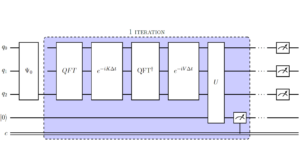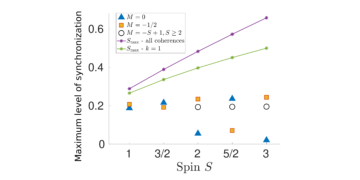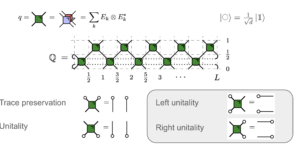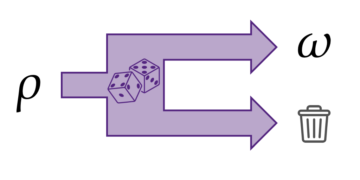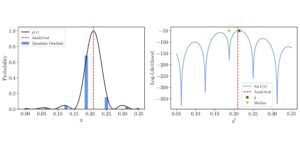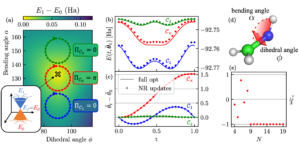Max Planck Institute for the Science of Light, Staudtstrasse 2, 91058 Erlangen, Germany
Find this paper interesting or want to discuss? Scite or leave a comment on SciRate.
Abstract
One of the most puzzling consequences of interpreting quantum mechanics in terms of concepts borrowed from classical physics, is the so-called wave-particle duality. Usually, wave-particle duality is illustrated in terms of complementarity between path distinguishability and fringe visibility in interference experiments. In this work, we instead propose a new type of complementarity, that between the continuous nature of waves and the discrete character of particles. Using the probabilistic methods of quantum field theory, we show that the simultaneous measurement of the wave amplitude and the number of photons in the same beam of light is, under certain circumstances, prohibited by the laws of quantum mechanics. Our results suggest that the concept of “interferometric duality” could be eventually replaced by the more general one of “continuous-discrete duality”.
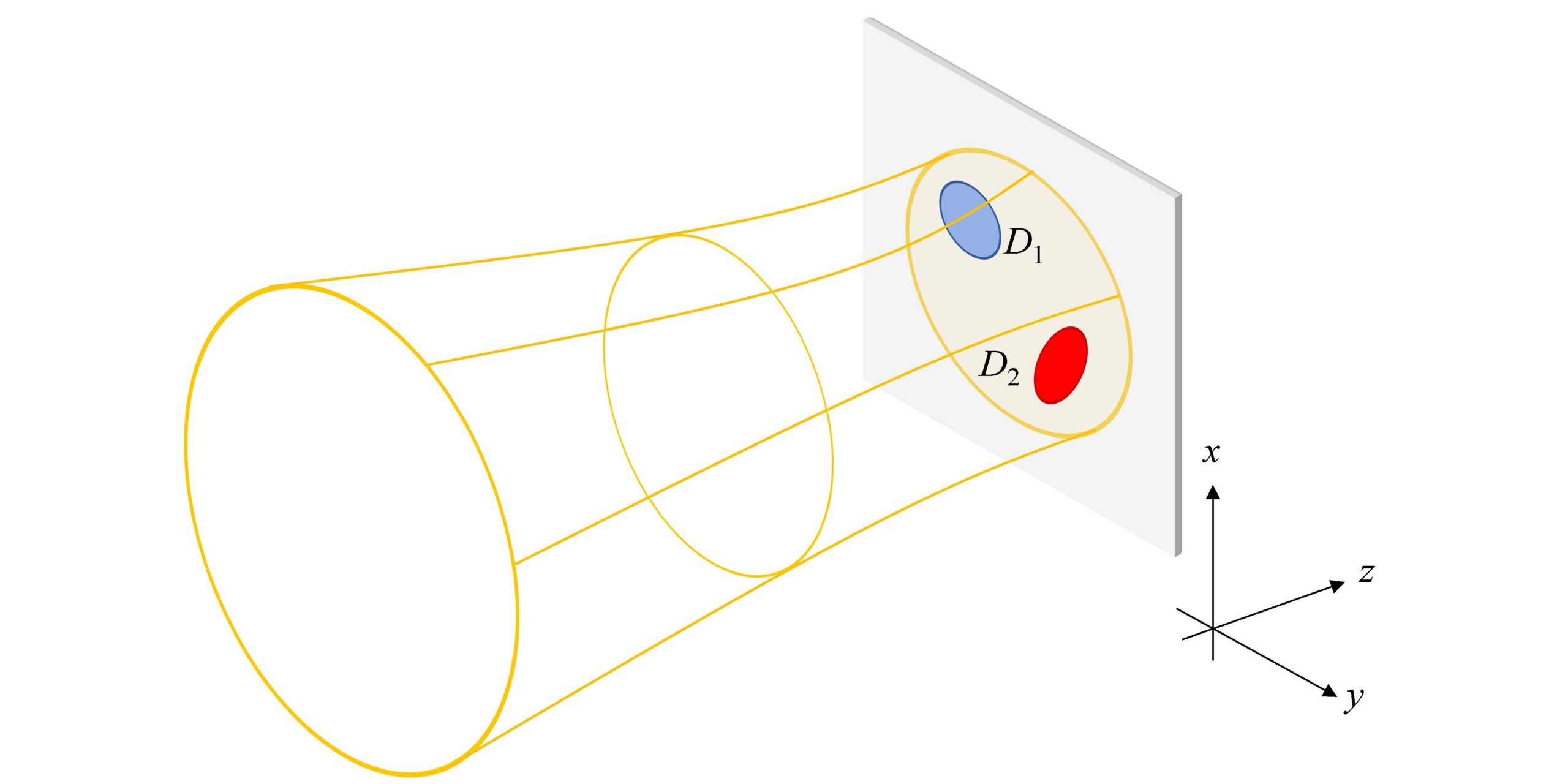
Featured image: A wave-like and a particle-like observables of a light beam prepared in a single-photon state, are measured simultaneously by the two separate detectors $D_1$ and $D_2$, respectively.
Popular summary
Things are essentially different in the quantum world, where wave and particle aspects are both present in the description of the same physical system, such as an electron or a photon. This fact of nature is called wave-particle duality and manifests itself, for example, in double-slit interference experiments. As Richard Feynman wrote in his celebrated lectures on physics, wave-particle duality is “[…] a phenomenon which is impossible, $absolutely$ impossible, to explain in any classical way, and which has in it the heart of quantum mechanics. In reality, it contains the $only$ mystery.”
In this paper we study the problem of wave-particle duality by exploiting the fundamental fact that the amplitudes of waves vary continuously, whereas particles can be counted one by one. For this study, we consider a light beam excited in a single-photon state, which impinges upon two distinct detectors. The first detector measures the continuous values of a quadrature of the electromagnetic field. The second detector simultaneously counts the discrete number of photons that fall on it. We find that the outcomes of these two simultaneous measurements are linearly uncorrelated but statistically dependent. In other words, the wave (quadrature) and particle (photon number) aspects of light coexist and affect each other in a nontrivial way.
These results also suggests that linear correlations, which are commonplace in many applications of quantum mechanics, may in some cases not provide a complete picture of a quantum system. The use of probability distributions describing the results of measurements of the physical observables of the system, becomes mandatory to obtain an accurate description of the latter.
► BibTeX data
► References
[1] Herbert Goldstein, Charles Poole, and John Safko, Classical Mechanics (Pearson, 2001), 3rd ed., ISBN 9780201657029.
[2] Fetter, Alexander L. and Walecka, John Dirk, Theoretical Mechanics of Particles and Continua (Dover Publications, Inc., Mineola, New York, 2003), ISBN 978-0486432618.
[3] Kimball A. Milton and Julian Schwinger, Electromagnetic Radiation: Variational Methods, Waveguides and Accelerators (Springer Berlin, Heidelberg, 2006), ISBN 978-3-540-29304-0, URL https://doi.org/10.1007/3-540-29306-X.
https://doi.org/10.1007/3-540-29306-X
[4] Alberto Galindo and Pedro Pascual, Quantum Mechanics I, Texts and Monographs in Physics (TMP) (Springer Berlin, Heidelberg, 1990), ISBN 978-3-642-83856-9, URL https://doi.org/10.1007/978-3-642-83854-5.
https://doi.org/10.1007/978-3-642-83854-5
[5] W. K. Wootters and W. H. Zurek, Phys. Rev. D 19, 473 (1979), URL https://doi.org/10.1103/PhysRevD.19.473.
https://doi.org/10.1103/PhysRevD.19.473
[6] P. Grangier, G. Roger, and A. Aspect, Europhysics Letters (EPL) 1, 173 (1986), URL https://doi.org/10.1209/0295-5075/1/4/004.
https://doi.org/10.1209/0295-5075/1/4/004
[7] A. Aspect and P. Grangier, Hyperfine Interactions 37, 1 (1987), ISSN 1572-9540, URL https://doi.org/10.1007/BF02395701.
https://doi.org/10.1007/BF02395701
[8] A. Aspect and P. Grangier, in Sixty-Two Years of Uncertainty: Historical, Philosophical, and Physical Inquiries into the Foundations of Quantum Mechanics, edited by A. I. Miller (Springer US, Boston, MA, 1990), pp. 45–59, ISBN 978-1-4684-8771-8, URL https://doi.org/10.1007/978-1-4684-8771-8_5.
https://doi.org/10.1007/978-1-4684-8771-8_5
[9] M. O. Scully, B.-G. Englert, and H. Walther, Nature 351, 111 (1991), ISSN 1476-4687, URL https://doi.org/10.1038/351111a0.
https://doi.org/10.1038/351111a0
[10] Paul Busch, Marian Grabowski, and Pekka J. Lahti, Operational Quantum Physics, Lecture Notes in Physics Monographs (Springer Berlin, Heidelberg, 1995), URL https://doi.org/10.1007/978-3-540-49239-9.
https://doi.org/10.1007/978-3-540-49239-9
[11] C. Dittel, G. Dufour, G. Weihs, and A. Buchleitner, Phys. Rev. X 11, 031041 (2021), URL https://doi.org/10.1103/PhysRevX.11.031041.
https://doi.org/10.1103/PhysRevX.11.031041
[12] X.-F. Qian, A. N. Vamivakas, and J. H. Eberly, Optica 5, 942 (2018), URL https://doi.org/10.1364/OPTICA.5.000942.
https://doi.org/10.1364/OPTICA.5.000942
[13] X.-F. Qian, K. Konthasinghe, S. K. Manikandan, D. Spiecker, A. N. Vamivakas, and J. H. Eberly, Phys. Rev. Res. 2, 012016 (2020), URL https://doi.org/10.1103/PhysRevResearch.2.012016.
https://doi.org/10.1103/PhysRevResearch.2.012016
[14] G. Jaeger, A. Shimony, and L. Vaidman, Phys. Rev. A 51, 54 (1995), URL https://doi.org/10.1103/PhysRevA.51.54.
https://doi.org/10.1103/PhysRevA.51.54
[15] B.-G. Englert, Phys. Rev. Lett. 77, 2154 (1996), URL https://doi.org/10.1103/PhysRevLett.77.2154.
https://doi.org/10.1103/PhysRevLett.77.2154
[16] H. M. Wiseman, F. E. Harrison, M. J. Collett, S. M. Tan, D. F. Walls, and R. B. Killip, Phys. Rev. A 56, 55 (1997), URL https://doi.org/10.1103/PhysRevA.56.55.
https://doi.org/10.1103/PhysRevA.56.55
[17] S. Dürr, T. Nonn, and G. Rempe, Nature 395, 33 (1998), ISSN 1476-4687, URL https://doi.org/10.1038/25653.
https://doi.org/10.1038/25653
[18] S. Dürr, T. Nonn, and G. Rempe, Phys. Rev. Lett. 81, 5705 (1998), URL https://doi.org/10.1103/PhysRevLett.81.5705.
https://doi.org/10.1103/PhysRevLett.81.5705
[19] G. Björk and A. Karlsson, Phys. Rev. A 58, 3477 (1998), URL https://doi.org/10.1103/PhysRevA.58.3477.
https://doi.org/10.1103/PhysRevA.58.3477
[20] P. D. D. Schwindt, P. G. Kwiat, and B.-G. Englert, Phys. Rev. A 60, 4285 (1999), URL https://doi.org/10.1103/PhysRevA.60.4285.
https://doi.org/10.1103/PhysRevA.60.4285
[21] S. Dürr and G. Rempe, American Journal of Physics 68, 1021 (2000), ISSN 0002-9505, URL https://doi.org/10.1119/1.1285869.
https://doi.org/10.1119/1.1285869
[22] R. Loudon, The Quantum Theory of Light (Oxford University Press, Oxford, 2000), ISBN 0 19 850176 5.
[23] V. Scarani and A. Suarez, American Journal of Physics 66, 718 (1998), URL https://doi.org/10.1119/1.18938.
https://doi.org/10.1119/1.18938
[24] V. Vedral, The quantum double slit experiment with local elements of reality (2021), URL https://doi.org/10.48550/arXiv.2104.11333.
https://doi.org/10.48550/arXiv.2104.11333
[25] C. Couteau, S. Barz, T. Durt, T. Gerrits, J. Huwer, R. Prevedel, J. Rarity, A. Shields, and G. Weihs, Nature Reviews Physics 5, 354 (2023), ISSN 2522-5820, URL https://doi.org/10.1038/s42254-023-00589-w.
https://doi.org/10.1038/s42254-023-00589-w
[26] M. Fuwa, S. Takeda, M. Zwierz, H. M. Wiseman, and A. Furusawa, Nature Communications 6, 6665 (2015), ISSN 2041-1723, URL https://doi.org/10.1038/ncomms7665.
https://doi.org/10.1038/ncomms7665
[27] C. Fabre and N. Treps, Rev. Mod. Phys. 92, 035005 (2020), URL https://doi.org/10.1103/RevModPhys.92.035005.
https://doi.org/10.1103/RevModPhys.92.035005
[28] J. von Neumann, Mathematical Foundations of Quantum Mechanics (Princeton University Press, Princeton, 2018), ISBN 9781400889921, URL https://doi.org/10.1515/9781400889921.
https://doi.org/10.1515/9781400889921
[29] A. Aiello, Spectral theorem for dummies: A pedagogical discussion on quantum probability and random variable theory (2022), URL https://doi.org/10.48550/arXiv.2211.12742.
https://doi.org/10.48550/arXiv.2211.12742
[30] K. P. Murphy, Probabilistic Machine Learning: An introduction (MIT Press, 2022), ISBN 9780262046824, URL http://probml.github.io/book1.
http://probml.github.io/book1
[31] Thomas M. Cover and Joy A. Thomas, Elements of Information Theory (John Wiley & Sons, Ltd, Hoboken, New Jersey, 2005), 2nd ed., ISBN 9780471241959, URL https://doi.org/10.1002/047174882X.
https://doi.org/10.1002/047174882X
[32] M. Hassani, C. Macchiavello, and L. Maccone, Phys. Rev. Lett. 119, 200502 (2017), URL https://doi.org/10.1103/PhysRevLett.119.200502.
https://doi.org/10.1103/PhysRevLett.119.200502
[33] L. Sarra, A. Aiello, and F. Marquardt, Phys. Rev. Lett. 126, 200601 (2021), URL https://doi.org/10.1103/PhysRevLett.126.200601.
https://doi.org/10.1103/PhysRevLett.126.200601
[34] A. Aiello, arXiv:2110.12930 [quant-ph] (2021), URL https://doi.org/10.48550/arXiv.2110.12930.
https://doi.org/10.48550/arXiv.2110.12930
arXiv:2110.12930
[35] J. W. Goodman, Introduction to Fourier Optics (Roberts & Company, Englewood, Colorado, 2005), 3rd ed.
[36] I. H. Deutsch, American Journal of Physics 59, 834 (1991), URL https://doi.org/10.1119/1.16731.
https://doi.org/10.1119/1.16731
[37] R. Haag, Local Quantum Physics, Texts and Monographs in Physics (Springer, Berlin, Heidelberg, 1992), 2nd ed., ISBN 978-3-642-61458-3, URL https://doi.org/10.1007/978-3-642-61458-3.
https://doi.org/10.1007/978-3-642-61458-3
[38] E. G. Peter Rowe, American Journal of Physics 47, 373 (1979), URL https://doi.org/10.1119/1.11827.
https://doi.org/10.1119/1.11827
[39] J. G. V. Bladel, Singular Electromagnetic Fields and Sources, The IEEE Series on Electromagnetic Wave Theory (IEEE Press, Piscataway, NJ, USA, 1991), ISBN 0-7803-6038-9.
[40] I. Agullo, B. Bonga, P. Ribes-Metidieri, D. Kranas, and S. Nadal-Gisbert, How ubiquitous is entanglement in quantum field theory? (2023), URL https://doi.org/10.48550/arXiv.2302.13742.
https://doi.org/10.48550/arXiv.2302.13742
[41] C. Itzykson and J.-B. Zuber, Quantum Field Theory (Dover Publications, Inc., Mineola, New York, USA, 2005), ISBN 0-486-44568-2.
[42] S. Coleman, Lectures of Sidney Coleman on Quantum Field Theory (World Scientific Publishing, Singapore, 2019), ISBN 978-981-4635-50-9, foreword by David Kaiser, URL https://doi.org/10.1142/9371.
https://doi.org/10.1142/9371
[43] W. P. Schleich, Quantum Optics in Phase Space (John Wiley & Sons, Ltd, Berlin, 2001), ISBN 9783527602971, URL https://doi.org/10.1002/3527602976.
https://doi.org/10.1002/3527602976
[44] Stephen M. Barnett and Paul M. Radmore, Methods in theoretical Quantum Optics, Oxford Series in Optical and Imaging Science: 15 (Oxford University Press, Oxford, UK, 2002), ISBN 0 19 856361 2.
[45] N. Bohr and L. Rosenfeld, Mat.-fys. Medii. Dan. Vid. Selsk. 12 (1933), for English translation see: Selected Papers of Léon Rosenfeld, eds. R. S. Cohen and J. Stachel (Boston Studies in the Philosophy of Science volume XXI) (Dordrecht: D. Reidel Pub., 1978) pp. 357–412.
[46] N. Bohr and L. Rosenfeld, Phys. Rev. 78, 794 (1950), URL https://doi.org/10.1103/PhysRev.78.794.
https://doi.org/10.1103/PhysRev.78.794
[47] W. Heitler, Quantum Field Theory (Dover Publications, Inc., Mineola, New York, USA, 1984), 3rd ed., ISBN 0-486-64558-4.
[48] J. D. Ramshaw, American Journal of Physics 53, 178 (1985), ISSN 0002-9505, URL https://doi.org/10.1119/1.14109.
https://doi.org/10.1119/1.14109
[49] V. Man’ko, L. Rosa, and P. Vitale, Physics Letters B 439, 328 (1998), ISSN 0370-2693, URL https://doi.org/10.1016/S0370-2693(98)01033-8.
https://doi.org/10.1016/S0370-2693(98)01033-8
[50] F. Reif, Fundamentals of Statistical and Thermal Physics (Waveland Press, Inc., 2009), ISBN 1-57766-612-7.
[51] S. A. Babichev, J. Appel, and A. I. Lvovsky, Phys. Rev. Lett. 92, 193601 (2004), URL https://doi.org/10.1103/PhysRevLett.92.193601.
https://doi.org/10.1103/PhysRevLett.92.193601
[52] G. Manfredi and M. R. Feix, Phys. Rev. E 62, 4665 (2000), URL https://doi.org/10.1103/PhysRevE.62.4665.
https://doi.org/10.1103/PhysRevE.62.4665
[53] J. F. Santos, C. H. Vieira, and P. R. Dieguez, Physica A: Statistical Mechanics and its Applications 579, 125937 (2021), ISSN 0378-4371, URL https://doi.org/10.1016/j.physa.2021.125937.
https://doi.org/10.1016/j.physa.2021.125937
[54] C. Nair, B. Prabhakar, and D. Shah, On entropy for mixtures of discrete and continuous variables (2007), https://doi.org/10.48550/arXiv.cs/0607075.
https://doi.org/10.48550/arXiv.cs/0607075
[55] W. R. Inc., Mathematica, Version 13.2, Champaign, IL, 2022, URL https://www.wolfram.com/mathematica.
https://www.wolfram.com/mathematica
[56] Eugene Hecht, Optics (Pearson Education, Inc., San Francisco, 2002), 4th ed., ISBN 0-8053-8566-5.
[57] R. Loudon, Phys. Rev. A 58, 4904 (1998), URL https://doi.org/10.1103/PhysRevA.58.4904.
https://doi.org/10.1103/PhysRevA.58.4904
[58] F. Töppel and A. Aiello, Phys. Rev. A 88, 012130 (2013), URL https://doi.org/10.1103/PhysRevA.88.012130.
https://doi.org/10.1103/PhysRevA.88.012130
[59] L. Mandel and E. Wolf, Optical Coherence and Quantum Optics (Cambridge University Press, New York, 1995).
[60] L. S. Schulman, Techniques and Applications of Path Integration (Dover Publications, Inc., Mineola, New York, USA, 2005), ISBN 0-486-44528-3.
Cited by
Could not fetch Crossref cited-by data during last attempt 2023-10-11 15:55:45: Could not fetch cited-by data for 10.22331/q-2023-10-11-1135 from Crossref. This is normal if the DOI was registered recently. On SAO/NASA ADS no data on citing works was found (last attempt 2023-10-11 15:55:45).
This Paper is published in Quantum under the Creative Commons Attribution 4.0 International (CC BY 4.0) license. Copyright remains with the original copyright holders such as the authors or their institutions.
- SEO Powered Content & PR Distribution. Get Amplified Today.
- PlatoData.Network Vertical Generative Ai. Empower Yourself. Access Here.
- PlatoAiStream. Web3 Intelligence. Knowledge Amplified. Access Here.
- PlatoESG. Carbon, CleanTech, Energy, Environment, Solar, Waste Management. Access Here.
- PlatoHealth. Biotech and Clinical Trials Intelligence. Access Here.
- Source: https://quantum-journal.org/papers/q-2023-10-11-1135/
- :has
- :is
- :not
- :where
- ][p
- 1
- 10
- 11
- 12
- 13
- 14
- 15%
- 16
- 17
- 178
- 19
- 1933
- 1984
- 1985
- 1995
- 1996
- 1998
- 1999
- 20
- 2000
- 2001
- 2005
- 2006
- 2013
- 2015
- 2017
- 2018
- 2019
- 2020
- 2021
- 2022
- 2023
- 22
- 23
- 24
- 25
- 26%
- 27
- 28
- 29
- 30
- 31
- 32
- 33
- 35%
- 36
- 39
- 3rd
- 40
- 41
- 49
- 4th
- 50
- 51
- 54
- 58
- 60
- 66
- 7
- 77
- 8
- 9
- 98
- a
- About
- ABSTRACT
- accelerators
- access
- accurate
- affect
- affiliations
- Alexander
- also
- American
- an
- and
- any
- appear
- appears
- applications
- ARE
- AS
- aspect
- aspects
- attempt
- author
- authors
- BE
- Beam
- becomes
- Berlin
- between
- BORROWED
- boston
- both
- Break
- busch
- but
- by
- called
- cambridge
- CAN
- cases
- celebrated
- certain
- character
- Charles
- circumstances
- cohen
- Colorado
- comment
- Commons
- Communications
- company
- complete
- concept
- concepts
- Consequences
- Consider
- contains
- continuous
- continuously
- copyright
- correlations
- could
- cover
- data
- David
- dependent
- describe
- described
- description
- different
- discuss
- discussion
- distinct
- distributions
- double
- during
- e
- each
- ed
- Education
- either
- elements
- English
- entanglement
- essentially
- eugene
- eventually
- example
- excited
- Exclusive
- experiment
- experiments
- Explain
- exploiting
- fact
- Fall
- field
- Fields
- Find
- First
- For
- found
- Foundations
- Francisco
- from
- fundamental
- Fundamentals
- General
- GitHub
- Goodman
- harvard
- Heart
- his
- historical
- holders
- How
- http
- HTTPS
- i
- IEEE
- if
- image
- Imaging
- impossible
- in
- In other
- Inc.
- information
- Inquiries
- instead
- Institute
- institutions
- integration
- interactions
- interesting
- Interference
- International
- into
- Introduction
- IT
- ITS
- itself
- JavaScript
- Jersey
- John
- journal
- jpg
- Last
- Laws
- learning
- Leave
- Lecture
- lectures
- License
- light
- local
- Ltd
- machine
- machine learning
- man
- mandatory
- many
- mathematical
- max-width
- May..
- measurement
- measurements
- measures
- mechanics
- methods
- Miller
- Milton
- MIT
- Month
- more
- most
- motion
- mutually
- Mystery
- Nature
- New
- New Jersey
- New York
- no
- normal
- Notes
- number
- object
- obtain
- Oct
- of
- often
- on
- ONE
- open
- operational
- optics
- or
- original
- Other
- our
- outcomes
- Oxford
- oxford university
- pages
- Paper
- papers
- path
- Paul
- pearson
- Peter
- phase
- phenomenon
- philosophy
- Photons
- physical
- Physics
- picture
- plato
- Plato Data Intelligence
- PlatoData
- Pollen
- POND
- prepared
- present
- press
- Princeton
- Problem
- propose
- provide
- publications
- published
- publisher
- Publishing
- Quantum
- Quantum Mechanics
- Quantum optics
- quantum physics
- R
- random
- rarity
- Reality
- recently
- references
- registered
- remains
- replaced
- represent
- Resort
- respectively
- Results
- Reviews
- Richard
- ROSA
- s
- same
- San
- San Francisco
- Science
- scientific
- Second
- see
- selected
- separate
- Series
- show
- simultaneously
- Singapore
- single
- singular
- some
- Sources
- Space
- Spectral
- State
- statistical
- Stephen
- STONE
- studies
- Study
- such
- suggest
- Suggests
- Surface
- suspended
- system
- Talk
- techniques
- terms
- that
- The
- the world
- their
- theoretical
- theory
- thermal
- These
- this
- Thus
- Title
- to
- Translation
- two
- type
- ubiquitous
- Uk
- Uncertainty
- uncorrelated
- under
- university
- upon
- URL
- us
- USA
- use
- using
- usually
- Values
- variable
- version
- View
- visibility
- volume
- von
- W
- want
- was
- Water
- Wave
- waves
- Way..
- we
- when
- whereas
- which
- with
- Wolf
- words
- Work
- works
- world
- wrote
- X
- year
- years
- york
- zephyrnet



